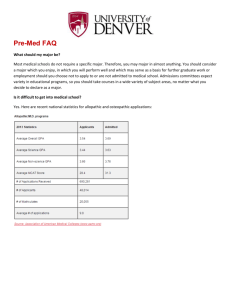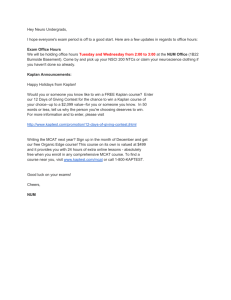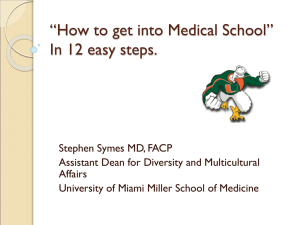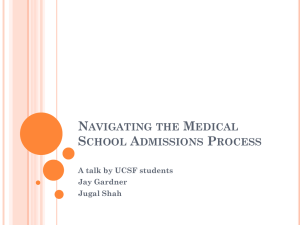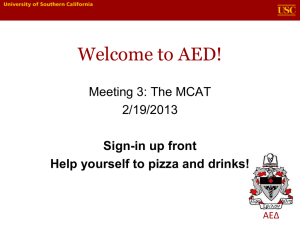doctor is one of the most intimidating decisions you
advertisement
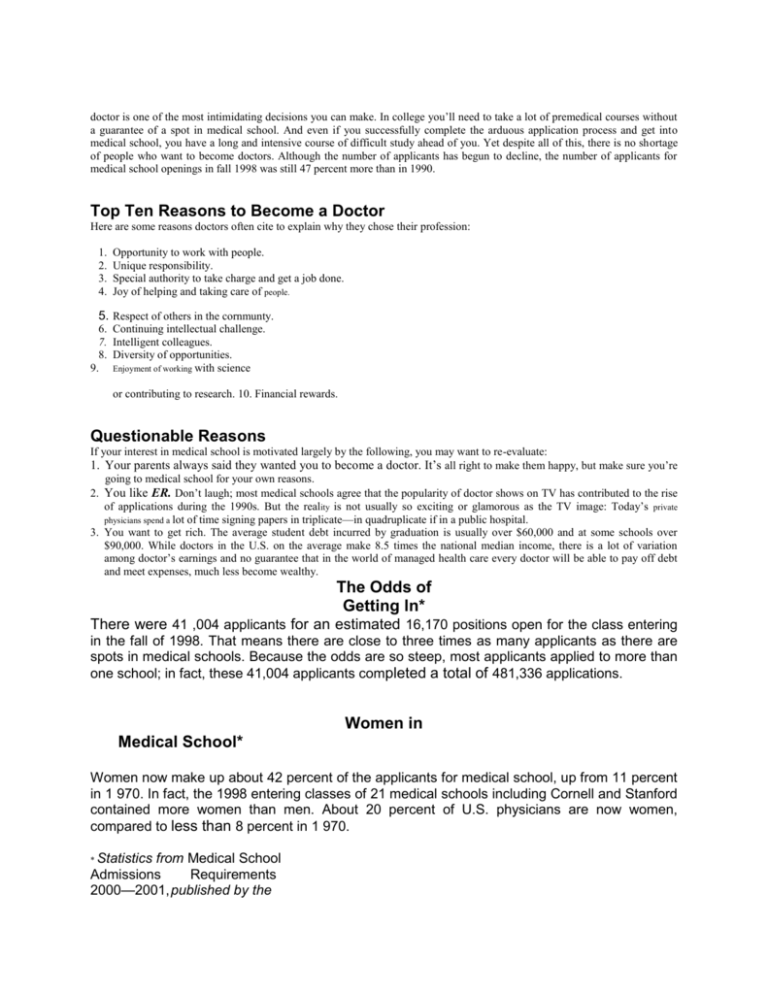
doctor is one of the most intimidating decisions you can make. In college you’ll need to take a lot of premedical courses without a guarantee of a spot in medical school. And even if you successfully complete the arduous application process and get into medical school, you have a long and intensive course of difficult study ahead of you. Yet despite all of this, there is no shortage of people who want to become doctors. Although the number of applicants has begun to decline, the number of applicants for medical school openings in fall 1998 was still 47 percent more than in 1990. Top Ten Reasons to Become a Doctor Here are some reasons doctors often cite to explain why they chose their profession: 1. 2. 3. 4. Opportunity to work with people. Unique responsibility. Special authority to take charge and get a job done. Joy of helping and taking care of people. 5. Respect of others in the cornmunty. 6. Continuing intellectual challenge. 7. Intelligent colleagues. 8. Diversity of opportunities. 9. Enjoyment of working with science or contributing to research. 10. Financial rewards. Questionable Reasons If your interest in medical school is motivated largely by the following, you may want to re-evaluate: 1. Your parents always said they wanted you to become a doctor. It’s all right to make them happy, but make sure you’re going to medical school for your own reasons. 2. You like ER. Don’t laugh; most medical schools agree that the popularity of doctor shows on TV has contributed to the rise of applications during the 1990s. But the reality is not usually so exciting or glamorous as the TV image: Today’s private physicians spend a lot of time signing papers in triplicate—in quadruplicate if in a public hospital. 3. You want to get rich. The average student debt incurred by graduation is usually over $60,000 and at some schools over $90,000. While doctors in the U.S. on the average make 8.5 times the national median income, there is a lot of variation among doctor’s earnings and no guarantee that in the world of managed health care every doctor will be able to pay off debt and meet expenses, much less become wealthy. The Odds of Getting ln* There were 41 ,004 applicants for an estimated 16,170 positions open for the class entering in the fall of 1998. That means there are close to three times as many applicants as there are spots in medical schools. Because the odds are so steep, most applicants applied to more than one school; in fact, these 41,004 applicants completed a total of 481,336 applications. Women in Medical School* Women now make up about 42 percent of the applicants for medical school, up from 11 percent in 1 970. In fact, the 1998 entering classes of 21 medical schools including Cornell and Stanford contained more women than men. About 20 percent of U.S. physicians are now women, compared to less than 8 percent in 1 970. * Statistics from Medical School Admissions Requirements 2000—2001, published by the Association of American Medical Colleges, 1999. SHOULD YOU GO TO MEDICAL SCHOOL? by Maria Lofftus Alternative Routes to Medical School 1. From college to medical school. Most medical students take this route, going into a premedical program in college. This option requires a commitment to go into medicine before the junior year in college. 2. From workplace to medical school. An increasing number of med cal students are deciding to go into medicine after they’re out of college and often after they’ve worked in a career for several years. Students going this route must go back to college to complete premedical course requirements. Some colleges offer a special postbaccalaureate premedical program for these people. 3. Combined college and medical school. A few schools offer the option of combining undergraduate college and medical school into one integrated program. This usually shaves a year off the time traditionally required to receive an M.D. But since this requires a commitment to become a doctor while still in high school, this option should not be chosen without careful consideration. General Information Premed Advisers Premed advisers have a lot of knowledge about medical schools and they are happy to share it with students. Alpha Epsilon Delta This premedical honor society offers information and support relating to admission requirements, the MCAT, and the application process. Contact your premed adviser to find the chapter on campus. American Medical Student Association The AMSA represents the concerns of physicians-in-training, including premedical students, interns, and residents across the country. http://www.amsa.org Medical School Admission Requirements Published by the Association of American Medical Colleges (AAMC), this book provides comprehensive information on all the accredited allopathic medical schools in the United States, Puerto Rico, and Canada. A new edition is available every April. Contact: Membership and Publication Orders, Association of American Medical Colleges, 2450 N Street, NW, Washington, DC 20037-1129 http://www. aamc.org Phone: (202) 828-0416 College Information Booklet and Education of the Osteopathic Physician These two books contain key information on osteopathic schools in the United States. They’re available from their publisher, the American Association of Colleges of Osteopathic Medicine. Contact: AACOM, 5550 Friendship Boulevard, Suite 310, Chevy Chase, MD 20815-7231 http://www.aacom.org Phone: (301) 968-4100 Admissions and the MCAT Association of American Medical Colleges (AAMC) The authority on medical education in the United States and Canada, this group administers the MCAT, runs a national application service (AMCAS), and publishes helpful directories and guides. Contact for MCAT: MCAT Program Office, 2255 North Dubuque Road, P.O. Box 4056, Iowa City, IA 52243-4056 http://www.aamc.org Phone: (319) 337-1357 Contact for AMCAS: AMCAS, Section for Student Services, 2450 N Street NW, Suite 201, Washington, DC 20037-1131 E-mail: amcas@aamc.org Phone: (202) 828-0600 American Association of Colleges of Osteopathic Medicine The AACOM represents the students and faculty of osteopathic schools in the United States. http://www.aacom.org Medical School Admissions Adviser This book from Kaplan and Newsweek features the information you need to develop your strategy to get into the medical school you want. The contents include advice on selecting a program, applying, writing your essay, preparing for the interview, and financing your degree. Special chapters for minority students, female students, and nontraditional students. Available in bookstores. Kaplan, Inc. The world’s leading test preparation company has prepared more students for the MCAT than anyone else. Kaplan provides assistance for every step of the admissions process, from selecting schools to taking the MCAT. http://www.kaptest.com Phone: (800) KAP-TEST Financial Aid Kaplan/American Express Student Loan Program Kaplan and American Express bring you this free financial aid and information service to get a head start on the financial aid process. http://www.kaploan.com Phone: (888) KAP-LOAN FinAid: The Financial Aid Information Page Free scholarship/fellowship search services, as well as descriptions of other financial aid sources is available at this site is sponsored by the National Association of Student Financial Aid Administrators. http://www.finaid.org Student Forums The Interactive Medical Student Lounge The Interactive Medical Student Lounge was designed for any medical or premed student with a Mac, PC, or handheld computer who wants to take a cyber study break. http://www.medstudents.net RESOURCES FOR MEDICAL SCHOOL SUCCESS Student National Medical Association This organization focuses on the concerns and issues faced by medical students of color. Many schools have local chapters. http://www.hsc.missouri.edu/ som/snma/ Selecting a School into into GRADUATE SCHOOL RESOURCE GUIDE 169 The MCAT, or Medical College Admission Test, is required for allopathic medical schools and all accredited osteopathic medical schools. Although the MCAT is both a skills- and knowledge-based exam, it places special emphasis on the thought processes considered necessary to build a successful career in medicine: analytical reasoning, abstract thinking, and problem solving. Anatomy of the MCAT The MCAT consists of four and three-quarters hours of multiple-choice testing (85 minutes of Verbal Reasoning, 100 minutes of Physical Sciences, and 100 minutes of Biological Sciences), plus one hour devoted to a Writing Sample. Add in the administrative details, plus three breaks (including lunch), and you can count on being in the room for well over six hours. Here’s a general overview of the MCAT: Time: Format: What it tests: 85 minutes 9 passages, 65 multiple-choice questions critical reasoning Physical Sciences Time: 100 minutes Format: 10—11 passages, 77 multiplechoice questions What it tests: basic general-chemistry concepts basic physics concepts analytical reasoning data interpretation_ Writing Sample TIme: Format: What it tests: 60 minutes 2 essay questions (30 minutes per essay) critical thinking intellectual organization written communication skills Biological Sciences Time: 100 minutes Format: 1 0—1 1 passages, 77 multiplechoice questions What it tests: basic biology concepts basic organic chemistry concepts analytical reasoning data interpretation Scoring Each MCAT section receives its own scaled score. Verbal Reasoning, Physical Sciences, and Biological Sciences scores range from 1 to 15. Writing Sample essays are scored alphabetically on a scale ranging from J to T, with T as the highest score. (The two essays are each evaluated by two official readers, so four critiques combine to make the alphabetical score.) All multiple-choice questions are worth the same amount—one raw point—and there’s no penalty for guessing. That means you should always fill in an answer for every question, whether you get to that question or not. Your score report will tell you—and your potential medical schools—not only your scaled scores, but also the national mean score for each section, standard deviations, national scoring profiles for each section, and your percentile ranking. There’s no such thing as a cut-and-dried “good score.” Much depends on the strength of the rest of your application and where you want to go to school. Here are a few interesting statistics. For each MCAT administration, the average scaled scores are approximately 8 for Verbal Reasoning, Physical Sciences, and Biological Sciences, and N for the Writing Sample. You need scores of at least 10—li to be considered competitive by most medical schools, and if you’re aiming for the top, you need to score 12 and above. But keep in mind that you don’t have to be perfect to do well. Even students who receive perfect scaled scores usually get a handful of questions wrong. Registration The MCAT is written by the Association of American Medical Colleges. The MCAT costs about $165. For the latest information on MCAT fees and score reporting plus a registration packet, contact your premed adviser, or: MCAT Program Office 2255 North Dubuque Road P.O. Box 4056 Iowa City, IA 52243 Tel: (319) 337-1357 Web Site: http://www.aamc.org/stuapps/admiss/mcatl The Sample Questions To introduce you to the MCAT, we’ve included sample passages and questions from the four sections that you will see on the test, including two Writing Sample topics. You can check your answers against the answer key on page 192. If you’d like to take a practice MCAT and receive personalized computer feedback (including a score), visit any Kaplan center. Good luck! the MCAT * Verbal Reasoning ‘MCAT is a registered service mark of the Association of American Medicd Coteges, which is not affi~iated with this product. 170 NEWSWEEK _____ CAREERS 2001
